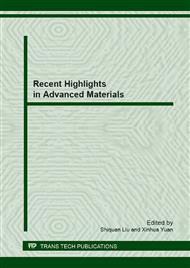[3]
Results and Discussion As shown in Tab. 1, all the parameters are taken from Heuchel's work[11] except Poisson ratio and coefficient of thermal expansion, which are assumed as 0. 48[7] and 11. 6e-5 /K[8], respectively. Considering the lack of experimental data and the inaccuracy of glass transition temperature, the parameters at shown in Tab. 1 are approximately taken at when the applied strain is 250%. And all the simulations are conducted in the viscoelastic model of COMSOL Multiphysics software. The geometrical model used in this paper is shown in Fig. 1. Table 1. Polyurethane's parameters for Maxwell-Weichert model under glass transition temperature.
DOI: 10.7554/elife.07545.011
Google Scholar
[39]
44 [min] 74 [] Fig. 1 Geometrical model for bending simulation.
Google Scholar
[3]
1 Relaxation and Creep As a viscoelastic material, Polyurethane possesses relaxation and creep properties. The geometrical model used in this section is the same with Fig. 1. After stretching sample to 250% at a strain rate of 5 mm/min at different temperatures respectively, the strain is kept constant for 6 hours at identical temperatures to allow relaxation. Shown in Fig. 2, the comparisons of simulated results and experimental results[11] for stress relaxation process are in good agreement with each other. Fig. 2 Stress relaxation curves under a strain 250% and different temperatures from the simulations and experiments. A force of 0. 01MPa is applied to the sample at a loading rate of 0. 0012 MPa/min at different temperatures respectively, stress is then kept constant for 1000 s at identical temperatures to allow creep. Fig. 3 shows the simulated results of creep processes using Maxwell-Weichert model. As shown in Fig. 3, the creep at glass transition temperature is most obvious while not at lower or higher temperatures, which is in good agreement with common sense. At elevated temperature, the creep cannot be observed as the shape changes too fast. While at lower temperature, the creep is so small and slow that it cannot be observed at short time. Fig. 3 Simulated results of creep process under a stress 0. 01 MPa and different temperatures.
Google Scholar
[3]
2 Shape Memory Properties As mentioned before, SMCP is a prerequisite of shape memory effects. Fig. 4 shows unconstrained recovery strain-temperature curves and constrained recovery stress-temperature curves under different strains. In Step 1, the sample is bended at 94 () by gradually ramping the bending strain at a loading rate of 1 mm/min to predefined values (1, 2, 3 mm in bending direction, respectively). Polymer segments are re-orientated while bending. In Step 2, the temperature is decreased to 54 () at a cooling rate of 1 while the nominal strain is fixed. In this step, the secondary cross-links form among the newly oriented polymer segments, and the deformed shape is fixed. In Step 3, the constraint is released at low temperature, and then an elastic strain recovers. The secondary cross-links are detached while the sample is reheated at a heating rate of 1 in step 4 under unconstrained or constrained conditions. In unconstrained recovery situation, the sample is reheated and the strain is recovered, as shown in Fig. 4a. In constrained recovery situation, the sample is re-constrained, reheated and the recovery stress is obtained, as shown in Fig. 4b. As the results show, the recovery stress increases with increasing strain or temperature. The trend that recovery stress increases with increasing temperature, which results from the detaching of secondary cross-links at high temperature, is in accordance with the experimental results of Ivens[] J. Ivens, M. Urbanus, C. De Smet, Shape recovery in a thermoset shape memory polymer and its fabric-reinforced composites, Express. Polym. Lett. 5 (2011).
Google Scholar
[3]
3 Influence of Recovery Temperature on Recovery Time Under higher recovery temperature, material modulus is lower, which results in lower carrying capacity and shorter recovery time, and vice versa. Consequently, appropriate recovery temperature should be taken to improve recovery efficiency under the precondition of ensuring the mechanical carrying capacity of SMPs and their composites. Hence the recovery temperatures for biomedicine SMPs and aviation SMPs composites should be higher and lower, respectively. After increasing temperature from 54 to 64, 74, 84 respectively at a heating rate of 1 in S4, the temperature is kept constant. As shown in Fig. 5, SMPs shape recovers slowly with the lapse of time at 64 , while recovers quickly at 74 , and recovers to its original shape immediately when the temperature is increased to 84 . Recovery time increases with decreasing recovery temperature, which is in agreement with experimental results of Yakacki[4]. Fig. 5 Simulated results of recovery time at different recovery temperatures.
Google Scholar
[4]
Conclusions (1) The Maxwell-Weichert model and time-temperature superposition principle are used to describe Polyurethane's creep, relaxation and shape memory processes. The simulated results show that the recovery stress increases with the increase of strain. (2) The balance between materials modulus and recovery time should be considered for different materials. Here, their relationships are analyzed. The results reveal that recovery time increases with the decrease of recovery temperature. Acknowledgements This work was supported by the National Key Basic Research Program of China (2010CB631100, 2012CB821500), the National Natural Science Foundation of China (51173100), and the Natural Science Foundation of Shandong Province (JQ201016). The submission is intended for the 2nd International Congress on Advanced Materials References.
DOI: 10.1520/stp39397s
Google Scholar


